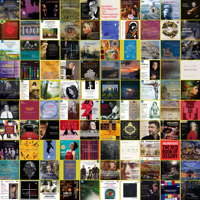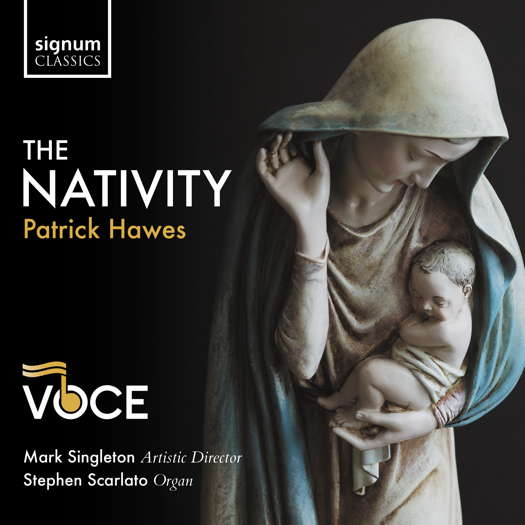- Johan Helmich Roman
- Chang Sun
- Jalal Zolfonun
- Anthony Caesar
- Marcello
- Romanos Melikyan
- Carol Neblett
- Gillian Wills: Big Music
 UPDATES: There's a new feature every day at Classical Music Daily. Read about the various ways we can keep in touch with you about what's happening here.
UPDATES: There's a new feature every day at Classical Music Daily. Read about the various ways we can keep in touch with you about what's happening here.
 DISCUSSION: John Dante Prevedini leads a discussion about Music and the Visual World, including contributions from Celia Craig, Halida Dinova and Yekaterina Lebedeva.
DISCUSSION: John Dante Prevedini leads a discussion about Music and the Visual World, including contributions from Celia Craig, Halida Dinova and Yekaterina Lebedeva.

Synergies of Tradition
JOHN DANTE PREVEDINI is impressed by the Christmas music of Patrick Hawes
'... meticulously conceived across every perceptible dimension ...'
The Nativity is the recent release from Signum Classics of a collection of Christmas choral works by Patrick Hawes, performed by the US-based VOCE chamber choral ensemble of Hartford, CT under the direction of Mark Singleton with Stephen Scarlato on organ and the composer on piano. The hour-long album features two multi-movement works, the titular Nativity and the Four Christmas Motets, along with ten short single-movement pieces. The release is available in both CD and digital format, and the booklet contains introductory notes by the composer and full texts, the latter stemming both from traditional sources (both English and Latin) and from Andrew Hawes, brother of the composer.
Over the course of its twenty tracks, the album showcases Hawes as a composer with a voice that is inventive yet accessible, someone whose musical language is deeply steeped in the tradition of the choral idiom while possessing a versatile facility for sophisticated reinvention within it. For instance, listeners may come away reminded sometimes of Renaissance polyphony, sometimes of the late Romantic choral traditions or sometimes of folk polyphony. In Hawes' harmonic vocabulary, tonality, modality, open-fifth sonorities, chromatic harmony and contemporary pan-diatonicism coexist freely along an integrated and organic continuum. Likewise, his textural palette pivots continuously between homorhythmic and polyphonic structures, and the scoring of his music regularly creates variety through contrasts between soli and tutti passages and, when applicable, between voices and instruments.
The album opens with three stand-alone works on texts from traditional sources. What Child Is This? is a tranquil homophonic piece with an angular melodic shape in the soprano line. Hawes' compositional voice here seems to have influences from both Baroque and Romantic idioms, and his harmonic language is fully tonal. The next piece, In Bethlehem, That Noble Place, is similarly homophonic but with a slightly faster tempo, a louder dynamic level and staggered entrances of the voice parts. The language is also similarly tonal, though with some open fifths at cadences. This is followed by This Endernight, a brisk triple-meter piece with staccato organ accompaniment apparently in eighth notes at a medium dynamic level. The harmony here mostly employs major sonorities, though the Lydian mode is evoked in many moments.
Listen — Patrick Hawes: This Endernight
(SIGCD752 track 3, 0:00-0:30) ℗ 2023 Signum Records Ltd :
The a cappella six-movement Nativity on texts by Andrew Hawes follows, opening with movement one, 'The Manger'. This is a slow and tranquil homophonic movement in triple meter with advanced tonal harmony featuring extended chords and diatonic clusters. Movement two, 'The Infant', has a moderately quick tempo in duple meter, and it features some of the extended harmonies of the previous movement with a greater degree of imitative polyphony. Movement three, 'The Oxen', has a similar tempo and meter to the previous movement, though the dynamic is quieter, and the harmony features more open fifths and modal flavors. Four-voice textures alternate with two-voice textures in a manner that might remind some listeners of William Billings. The fourth movement, 'The Shepherds', is more polyphonically complex in a lively triple meter. This is followed by 'The Star', a slow and quiet duple-meter movement in a homophonic texture with a very effective use of suspended harmonies and complex chromic tonality. The Nativity closes with 'The Magi', a lively duple-meter movement featuring the higher registers of the voices in imitative polyphony.
Listen — Patrick Hawes: The Magi (The Nativity)
(SIGCD752 track 9, 0:00-0:30) ℗ 2023 Signum Records Ltd :
After The Nativity are three stand-alone works, also on texts by Andrew Hawes. Joseph's Carol is a slow quadruple-meter piece for male voices with organ. The harmonies here are considerably more modal than those of other pieces heard so far on the album, and the overall effect of the voicing is very sonorous in the context of the piece's sonic palette. This is followed by Still, Still the Night, a moderate-tempo composition in triple meter. The piece opens with a homophonic texture on long notes before gradually transforming in complexity through what appear to be embellishing eighth-note passages. Behold The King for choir with organ is next, a very bright and triumphant piece in a fast quadruple meter.
Four Christmas Motets on traditional Latin texts follows next, opening with the first movement 'Virga Jesse'. This slow, homophonic movement has a very enigmatic character with diatonic harmonies creating a sense of key-center ambiguity through chordal extensions before resolving in a more conventionally 'tonal' sense. The second movement is the lively 'Puer Natus', which alternates unison monophony with ensemble homophony in the high registers, creating a timbral effect that is both warm and bright. This is followed by the slower third movement, 'Nesciens Mater', which has a quasi-fugal texture evoking the Phrygian mode through a sophisticated blend of diatonic harmony including tone clusters, open fifth sonorities and traditional triads and seventh chords. The fourth and final movement is the fast triple-meter 'Gaudete Omnes', which has a very bright staccato character and features much syncopation and imitative polyphony.
Listen — Patrick Hawes: Gaudete Omnes (Four Christmas Motets)
(SIGCD752 track 16, 0:00-0:30) ℗ 2023 Signum Records Ltd :
The album closes with four more single-movement works. The Heart of Mary, with text by Andrew Hawes, is a moderately slow and quiet triple-meter piece emphasizing the low registers with a triadic harmonic language rich in suspended harmonies. This is followed by Minstrels, on a poem by William Wordsworth, a moderate duple-meter piece showcasing a stark juxtaposition of staccato and legato passages layered together in the voices. Next is a setting of the traditional text Lullay My Liking, a slightly faster piece with a moderate dynamic level and a sonorous harmonic effect in the lower registers of the voices. Finally, the album ends with The Colours of Christmas on a text by Andrew Hawes, a moderate-tempo piece in triple meter with piano accompaniment seemingly in eighth notes and the choral melody in longer notes. The piece culminates in a quiet a cappella climax before closing with a piano solo.
As a listening experience, the Nativity album seems meticulously conceived across every perceptible dimension, from Hawes' reflective composition of the repertoire itself to the sensitive execution by Singleton and Scarlato with VOCE, including the thoughtful use of the acoustical environment (Immanuel Congregational Church of Hartford, CT) such that the music leaves space to truly complement - and not just accommodate - the building's considerable reverberation time. Considering Signum's elegantly understated presentation of this material in a manner appropriate for a traditional Christmas choral album, these salient qualities arguably bear mentioning as an inherent part of the album's effectiveness, lest they go unnoticed by the more casual listener. In conclusion, this refreshing and restorative choral album showcases a remarkable array of synergies between traditional elements in a deceptively conservative idiom, namely Christmas choral music. It goes to show that, when the creative spirit works in tandem with a commanding perspective, many new things can still be said with historic palettes.
Copyright © 10 December 2023
John Dante Prevedini,
Connecticut, USA



